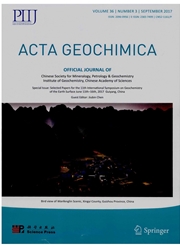

 中文摘要:
中文摘要:
由作为例子拿 Tarim 盆,四川盆和 Ordos 盆,为深海洋的水库形成的条件在下面列出的三个方面被说明:迟了阶段的重迭风格,埋葬历史和海洋的 stratigraphic 系统的结构的变丑。海洋的来源岩石的埋葬历史能被划分成三种类型,即,类型我,类型 II 和类型 III,它以烃产生和石油水库形成与有现在的烃阶段的盒子显然不同。基于进化历史,在海洋的 stratigraphic 顺序的结构的带能也被划分成四种类型,即更早正常的差错以后的差错褶层类型,更早的高举以后差错褶层类型,更早的高举以后弄平斜坡类型,和更早消沉以后的戳类型。在这篇论文,一个连续煤气的产生模型被建议,并且它特别地被指出退火的那对地热的地从驱散的液态烃在的进化和构造沉淀和晚煤气的产生高度成熟到过去成熟的来源岩石是为海洋的石油水库的形成的关键因素。为在深海洋的系统,盖住的早烃注射,深剥光和埋葬的化成白云石的高级水库的形成的地质的条件,被总结。三主修,这最后被结束结构的带,即合成的烃累积描绘的 paleo 高举带, paleo 差错带 andhigh 精力沉积外形带,涉及海洋的烃累积。
 英文摘要:
英文摘要:
By taking the Tarim Basin, Sichuan Basin and Ordos Basin as examples, the conditions for deep marine reservoir formation were illustrated in three aspects listed below: late-stage superimposition style, burial history and structural deformation of the marine stratigraphic system. The burial history of marine source rocks can be divided into three types, i.e., type I, type II and type III, which are obviously different from the case with present hydrocarbon phases in terms of hydrocarbon generation and pe- troleum-reservoir formation. Based on evolution history, the structural belts in the marine stratigraphic sequence can also be divided into four types, i.e. earlier normal fault-later fault-fold type, earlier uplift-later fault-fold type, earlier uplift-later flattened slope type, and earlier depression-later thrust type. In this paper, a successive gas generation model was proposed, and it was particularly pointed out that coupling of geothermal field annealing evolution and tectonic subsidence and late gas generation from dispersed liquid hydrocarbon in highly matured to over-matured source rocks are key factors for formation of marine petroleum reservoirs. The geological conditions for formation of high-grade reservoirs in deep marine system, covering early hydrocarbon injection, deep denudation and buried dolo- mitization, were summarized. It was finally concluded that three major structural belts, i.e. paleo-uplift belt characterized by composite hydrocarbon accumulation, paleo-fault belt and high-energy sedimentary facies belt, were involved in marine hydrocarbon accumulation.
 同期刊论文项目
同期刊论文项目
 同项目期刊论文
同项目期刊论文
 期刊信息
期刊信息
